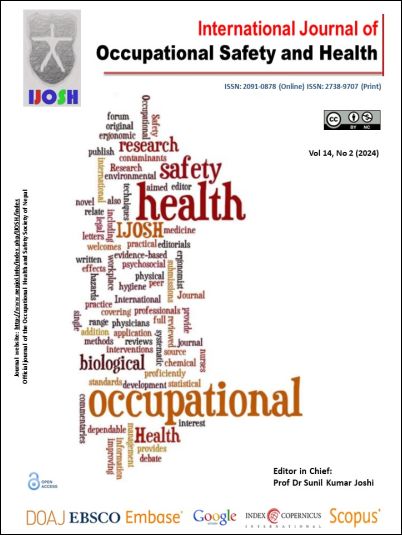Estimation of Atraumatic Hip Microinstability Among Long Distance Truck Drivers in Western Maharashtra : A Cross-Sectional Study
DOI:
https://doi.org/10.3126/ijosh.v14i2.51635Keywords:
Hip micro-instability, Laxity, Truck drivers, Years of drivingAbstract
Introduction: Hip micro-instability is an upcoming concern and is gaining acceptance as an important contributing factor for hip joint dysfunction among adults and is a major risk factor for the development of early osteoarthritis. Around 20-25% of people at the age of 50 suffer hip pain and knee pain because of chronic wear and tear of joint articular cartilage. is typically described as painful extra-physiologic hip movements, either alone or in combination with symptoms of unstable hip joints. Truck drivers travel long routes for an extensive duration of time with their hips in an ergonomically compromised position. Occupational stress can cause pain which is an effect of vibrational forces and postural stress. Investigation suggests that hip musculoskeletal pain as a whole is one of the main causes of hip micro-instability. Hence, it is important to evaluate the presence of hip micro-instability among long-distance truck drivers.
Methods: A cross-sectional study was conducted from 4 May 2023 in a rural tertiary care hospital in Karad for about 6 months. Wherein a total of 103 long-distance truck drivers were randomly selected based on the inclusion criteria which included truck drivers by occupation within the age group of 35-45 years, working for more than 12 hours in a day and for 5 days/week with no history of trauma. They were assessed by using the Anterior Apprehension Test, Prone Apprehension Test, and AB-HEER test. The data was then analyzed using statistical procedures, and the results were obtained.
Results: The present study shows that over 12% of participants showed positive results for hip micro-instability. A significant positive correlation was observed between the number of years of driving in relation to pain (P value < 0.0001). On assessment, there was an increase in flexion, adduction, and internal rotation ranges which hence revealed anterior hip micro-instability (P value = 0.0121) as compared to extension, abduction and external rotation ranges which revealed posterior instability.
Conclusion: The study concluded that over 12% of participants showed positive results for hip micro-instability. Also, anterior hip micro-instability was more as compared to posterior hip micro-instability amongst the truck drivers due to capsular relaxation which was affected due to prolonged hours of poor ergonomics. This study also showed the existence of micro-instability despite the presence or absence of ligamentous laxity.
Downloads
Downloads
Published
How to Cite
Issue
Section
License
Copyright (c) 2024 The Author(s)

This work is licensed under a Creative Commons Attribution-NonCommercial 4.0 International License.
This license enables reusers to distribute, remix, adapt, and build upon the material in any medium or format for noncommercial purposes only, and only so long as attribution is given to the creator.





